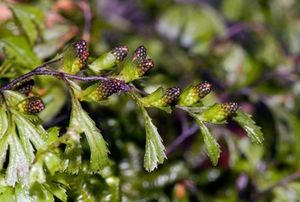 Hymenophyllum revolutum. Photographer: Jeremy Rolfe.Ferns are characterised in four main ways. Firstly they are green, that is they contain chlorophyll and obtain their energy from sunlight using true leaves (megaphylls). Secondly they do not flower. Thirdly they reproduce by spores rather than seed. Spores are unicellular structures that are barely visible to the naked eye. Finally ferns have a complex life cycle involving both a sporophyte and gametophyte stage.
Hymenophyllum revolutum. Photographer: Jeremy Rolfe.Ferns are characterised in four main ways. Firstly they are green, that is they contain chlorophyll and obtain their energy from sunlight using true leaves (megaphylls). Secondly they do not flower. Thirdly they reproduce by spores rather than seed. Spores are unicellular structures that are barely visible to the naked eye. Finally ferns have a complex life cycle involving both a sporophyte and gametophyte stage.
The sporophyte is the plant that most people recognise as being a fern and it is this stage that is spore-bearing.
The gametophyte (also known at the prothallus) is a plant with a small, flat, heart-shaped body. It is in this stage that sexual reproduction occurs. This plant produces sperm and egg cells in special reproductive organs and following fertilisation a new sporophyte is produced.
There are approximately 20,000 fern species worldwide and they all sit in the division Pteridophyta of the phylum Tracheophyta.
Provided here is information about various types of fern:
- True (Leptosporangiate) ferns
- Adder’s tongue ferns (Ophioglossaceae)
- Fork and whisk ferns (Psilotaceae)
- Horsetails (Equisetaceae)
- King fern (Marattiaceae)
For more information about ferns see
- New Zealand ferns and allied plants by Patrick Brownsey and John Smith-Dodsworth.
- The Hidden Forest
- Ferns - New York Botanic gardens
- Ferns (Wikipedia)
- Smith, A.R.; Pryer, K.M.; Schuettpelz, E.; Korall, P.; Schneider, H.; Wolf, P.G. (2006). A classification of extant ferns. Taxon 55 (3): 705-731
